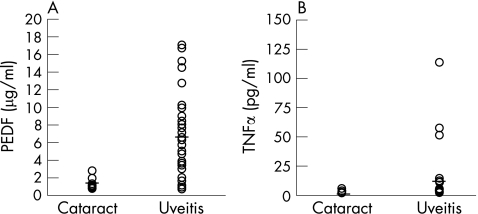Abstract
Aim
To evaluate whether aqueous humor levels of pigment epithelium‐derived factor (PEDF) are increased in patients with uveitis
Methods
Aqueous humor levels of PEDF and tumour necrosis factor α (TNFα) were determined by ELISA in 34 uveitis samples and 9 cataract control samples.
Results
Aqueous humor PEDF and TNFα levels were significantly higher in patients with uveitis than in controls (mean (SD) 6.4 (0.8) v 1.3 (0.2) μg/ml and 14.7 (3.8) v 4.2 (0.4) pg/ml, respectively; p<0.01). A positive correlation between PEDF and TNFα was found in patients with uveitis (r = 0.40, p<0.01). Furthermore, PEDF levels in aqueous humor were increased in proportion to the disease activity of uveitis.
Conclusion
The results show that aqueous humor levels of PEDF are increased in patients with uveitis. Our observations suggest that aqueous humor levels of PEDF may be increased as a countersystem against inflammation in uveitis.
Pigment epithelium‐derived factor (PEDF) was first purified from the conditioned media of human retinal pigment epithelial cells with neuronal differentiating activity.1 Recently, PEDF has been shown to be the most potent inhibitor of angiogenesis in the mammalian eye; it inhibited retinal endothelial cell growth and migration and suppressed ischaemia‐induced retinal neovascularisation.2 In addition, PEDF decreased retinal levels of pro‐inflammatory cytokines in experimental diabetes, thus acting as an endogenous anti‐inflammatory factor as well.3 As PEDF levels in vitreous are decreased in patients with diabetes with proliferative retinopathy,4 loss of PEDF in the eye could contribute to diabetic retinopathy. However, the role for PEDF in inflammatory eye disease such as uveitis is not fully understood. In this study, we examined whether aqueous humor levels of PEDF were increased or decreased in patients with active uveitis. We further studied the relation of aqueous humor levels of PEDF with those of tumor necrosis factor (TNF)α and disease activity in patients with uveitis.
Patients and methods
Informed consent was obtained from all patients. Patients with various clinical entities of strictly diagnosed active uveitis with a mean (standard deviation (SD)) age of 48.5 (2.7) years (n = 34; 13 with infectious uveitis and 21 with non‐infectious uveitis) were studied. Aqueous humor was collected from the patients under aseptic conditions. Nine aqueous humor samples were obtained during surgery from patients with cataract with a mean (SD) age of 65.2 (2.7) years, and served as controls. Aqueous humor levels of PEDF and TNFα were measured as described previously.5 Interassay (n = 17) and intra‐assay (n = 14) coefficients of variation of the PEDF ELISA were 4.7% and 7.3%, respectively.5 We classified patients with uveitis into four groups on the basis of the extent of disease activity evaluated by slit‐lamp biomicroscopy as described previously.6 The data were analysed by the Mann–Whitney U test and Pearson's correlation coefficient by rank test.
Results and discussion
Figures 1A and B show the mean (SD) aqueous humor levels of PEDF and TNFα that were significantly higher in patients with uveitis than in controls (6.4 (0.8) v 1.3 (0.2) μg/ml and 14.7 (3.8) v 4.2 (0.4) pg/ml; respectively, p<0.01). Aqueous humor levels of PEDF in patients with infectious uveitis were significantly higher than in those with non‐infectious uveitis (8.4 (1.3) v 5 (0.9) μg/ml, p<0.05). A positive correlation between PEDF and TNFα was found in patients with uveitis (r = 0.40, p<0.01; fig 2A). Furthermore, PEDF levels in aqueous humor were increased in proportion to the disease activity of uveitis (fig 2B).
Figure 1 Aqueous humor levels of pigment epithelium‐derived factor (PEDF; A) and tumour necrosis factor (TNF)α (B) in patients with uveitis and in those with cataract (controls). The horizontal line indicates the mean concentration calculated using the Mann–Whitney U test.
Figure 2 Correlation between the aqueous humor levels of pigment epithelium‐derived factor (PEDF) and those of tumour necrosis factor (TNF)α (A) and disease activity (B) in patients with uveitis. Pearson's correlation coefficient calculated using rank test.
Our results show for the first time that aqueous humor levels of PEDF are increased in patients with uveitis, and are correlated with those of TNFα and disease activity. We have recently found that PEDF inhibits the TNFα‐induced interleukin‐6 expression in endothelial cells through its antioxidative properties.7 In addition, Zhang et al3 reported that PEDF could contribute to diabetic retinopathy as an endogenous anti‐inflammatory factor. Taken together, our findings suggest that aqueous humor levels of PEDF may be increased as a countersystem against inflammation in uveitis and may be a novel biomarker for the activity of uveitis.
Abbreviations
PEDF - pigment epithelium‐derived factor
TNFα - tumour necrosis factor α
Footnotes
Competing interests: None decalared.
References
- 1.Tombran‐Tink J, Chader C G, Johnson L V. PEDF: pigment epithelium‐derived factor with potent neuronal differentiative activity. Exp Eye Res 199153411–414. [DOI] [PubMed] [Google Scholar]
- 2.Duh E J, Yang H S, Suzuma I.et al Pigment epithelium‐derived factor suppresses ischemia‐induced retinal neovascularization and VEGF‐induced migration and growth. Invest Ophthalmol Vis Sci 200243821–829. [PubMed] [Google Scholar]
- 3.Zhang S X, Wang J J, Gao G.et al Pigment epithelium‐derived factor (PEDF) is an endogenous anti‐inflammatory factor. FASEB J 200620323–325. [DOI] [PubMed] [Google Scholar]
- 4.Spranger J, Osterhoff M, Reimann M.et al Loss of the antiangiogenic pigment epithelium‐derived factor in patients with angiogenic eye disease. Diabetes 2002502641–2645. [DOI] [PubMed] [Google Scholar]
- 5.Yamagishi S, Adachi H, Abe A.et al Elevated serum levels of pigment epithelium‐derived factor (PEDF) in the metabolic syndrome. J Clin Endocrimol Metab 2006912447–2450. [DOI] [PubMed] [Google Scholar]
- 6.Verma M J, Lloyd A, Rager H.et al Chemokines in acute anterior uveitis. Curr Eye Res 1997161202–1208. [DOI] [PubMed] [Google Scholar]
- 7.Yamagishi S, Inagaki Y, Nakamura K.et al Pigment epithelium‐derived factor inhibits TNF‐alpha‐induced interleukin‐6 expression in endothelial cells by suppressing NADPH oxidase‐mediated reactive oxygen species generation. J Mol Cell Cardiol 200437497–506. [DOI] [PubMed] [Google Scholar]




